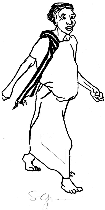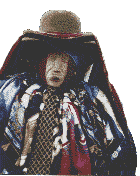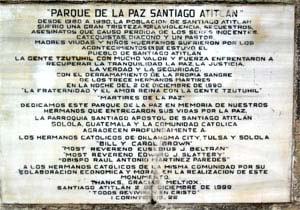 |
The 1990 Uprising |
||
SantiagoAround the Lake Atitlán Today History Pre Colombian The Conquest Chuitinamit The 1990 Uprising Weaving Art Mayan ReligionFeria Social Projects Local Business Tienda Santiago Links Photo Archive 2005 Disaster Music Festival Virtual Maximon
Lealo en Español

|
Beginning in about 1979 the political problems that were sweeping across
Central America were starting to be felt in Santiago. While the revolution
in Nicaragua heated up the various sides of the spectrum here in Guatemala
started acting up. The leftist leaning folks were getting ready for the liberation
and the right-wingers were desperately doing The Army set up a "temporary" base that lasted for 10 years on the site of the massacre. They never really built it up, they kind of camped out the whole time in tents. They also had large lime pits dug for their dirty work. These were discovered after the military left. Groups of guerillas from ORPA began to show up on the flanks of the Volcano, and the Army went chasing them, making a no-mans land of the volcanoes: anyone found up on the volcano was suspected of being a guerilla. The farmers had to abandon their fields and the peach orchards got seeded with land mines. The people from ORPA mostly showed up here because the hills behind Santiago form part of a wild corridor that goes from the highlands and the Ixil triangle to the coast. But as time went on, and the abuses from the soldiers mounted, the people from Santiago who had been pulled into the conflict started appearing on right wing death lists and many disappeared, some killed by the death squads, some left the country and went into exile in Mexico, some took to the hills and became guerillas. The whole town oozed with an underlying terror, as there was no logic behind who was accused or who was kidnapped. There were gunshots every night. The streets were empty by 8 o'clock. Masked armed men started breaking down peoples doors to steal whatever things they had, right down to their personal clothing. After Rios Montt took over as dictator and began his rather successful "beans or bullets" campaign in the highlands the amount of real guerillas that came through went way down. The local theory was that the military was being paid by the US to kill commies and if there weren't any left they would just have to fabricate some to keep the dollars coming in. There were many incidents here: over 1000 people from Santiago were killed or disappeared. The American priest was murdered at the church because he took in several people who were on the death list. For 10 years the people lived with this. Everyone you talk to lost someone in his or her family.
Then, early in the morning on Dec 2, 1990 things changed. The base had recently gotten a new commander, and he was a real sweetheart. At the time he had been celebrating with a couple of buddies for a couple of weeks, drinking for free in the cantinas, shooting his gun off in the air, demanding special treatment wherever he went. On the night of the first, after a rather rowdy night, he decided that he would go after this particularly good looking young lady, so he and his buddies made their way up to her house and started drunkenly pounding on her door, demanding to see her. Her family was terrified and started calling for help. A group of neighbors responded to the call and seized the commander and his friends, meaning to take them to the jailhouse. In the skirmish the commander let off a shot before they took him over. Back at the military base the shot was heard and a patrol was sent to check it out. When they got to town they came across the group of neighbors dragging commander to jail and, in the course of their intervention managed to shoot a young boy, paralyzing him from the waist down, before setting free the commander and whisking him back to the base. The group of neighbors reacted by going to the Catholic Church and ringing the bells to wake up the rest of the town. By now it was 1 o'clock in the morning.
|
||
The men from Atitlan set up a cordon around the base, not allowing anyone on or off the base. They wouldn't let anyone touch the bodies either. The original reports by the soldiers at the army base claimed that a guerilla group had attacked the base. At the time there was a stringer for the news services that just happened to be staying on the other side of town, and at 6 o'clock in the morning a commission came to get her. Her photographs and story helped the truth come out. The Atitecos started organizing: a defense committee was organized, and every man had to serve time on "rondas", unarmed groups of men doing neighborhood watches. The whole town got organized. A solid cordon was put around the base and a petition started circulating. There were eventually more than 20,000 signatures on this petition, which basically demanded that the military and the guerillas stay out of Santiago. This petition was taken to the city by some of the Atitecos who live there and it made it's way to the political circles. An election was coming up in Guatemala, and one after another of the politicians began to ask questions about Santiago. A Human Rights omnibudsman was sent to Santiago to deal with the problem. The ambiance in town was incredible: everyone got involved. Ma'chas went with a committee to the city to take the petition to the president and when he returned he was welcomed as a hero. The revolutionary spirit was very strong. The soldiers had quietly abandoned their base by boat, and the defense committee actually caught several groups of soldiers who obviously had been sent to check things out. A large group tried to set up camp in Cerro de Oro (about 5 miles away). Within an hour of their landing in their boats there was a huge crowd of hundreds of people who demanded that they leave. They did.
And finally, miraculously, the president Vinicio Cerezo, who had been the very same Human Rights omnibudsman who had come to Santiago originally, signed the papers that ordered the military forever away from Santiago Atitlan. A replica in stone of these orders stands at the site. A peace park was built on the place where most of the "martyrs" died. Since that time the army still is not permitted in Santiago. When the army left they unfortunately left a legacy: the peach orchards and lower flanks of the Toliman volcano were planted with mines, and, until a couple of years ago, ocasionally someone would run across one of them. In the local parlance, this event is called " the massacre", but, in reality, the heroic implications of the action are more accurately described as an uprising, and to label it as a massacre ignores the fact that thousands of irate Atitecos marched to the base demanding justice. Some carried sticks and stones and were definitely serious in their intentions. There is a small park at the site with crosses for the dead. Each year on the second of December there is a memorial service and all of the religions remember together. |
 This
view of the 1990 uprising is written by a longtime foreign resident who lived
in Santiago through a lot of the terror and was in Santiago at the time of
the uprising. The problems in Guatemala in the 80´s are pretty well
known, so I have chosen not to dwell on the details except as to how it all
related to Santiago. First, I must say that, although Santiago was caught
up in the conflict and was considered by the government to be a hotbed of
subversion, the people here are very firmly capitalistic in temperament and
frankly too anarchistic to be communists.
This
view of the 1990 uprising is written by a longtime foreign resident who lived
in Santiago through a lot of the terror and was in Santiago at the time of
the uprising. The problems in Guatemala in the 80´s are pretty well
known, so I have chosen not to dwell on the details except as to how it all
related to Santiago. First, I must say that, although Santiago was caught
up in the conflict and was considered by the government to be a hotbed of
subversion, the people here are very firmly capitalistic in temperament and
frankly too anarchistic to be communists.  whatever they could to keep
the communists out. Students from the University in the city were coming
out into the countryside to try and organize the Indians, while the private
armies started looking for enemies. Added to this were the truckloads of
teenage soldiers (some as young as 14) that drove all over the place looking
for trouble. At this time there still weren't very many military bases established
so it was the only way for the military to control so much territory. There was a tragic incident where 25 people (bystanders) had been killed
by a truckload of soldiers who believed that they were under attack by guerillas
when they heard a rifle shot. It turns out that it was a duck hunter on the
lake (He was one of the dead). The people who died were for the most part
farmers. The soldiers who did the job went crazy, torturing the people to
find out who the guerrillas were and finally throwing them out of a helicopter.
From this time the people of Santiago did not get along with the military.
whatever they could to keep
the communists out. Students from the University in the city were coming
out into the countryside to try and organize the Indians, while the private
armies started looking for enemies. Added to this were the truckloads of
teenage soldiers (some as young as 14) that drove all over the place looking
for trouble. At this time there still weren't very many military bases established
so it was the only way for the military to control so much territory. There was a tragic incident where 25 people (bystanders) had been killed
by a truckload of soldiers who believed that they were under attack by guerillas
when they heard a rifle shot. It turns out that it was a duck hunter on the
lake (He was one of the dead). The people who died were for the most part
farmers. The soldiers who did the job went crazy, torturing the people to
find out who the guerrillas were and finally throwing them out of a helicopter.
From this time the people of Santiago did not get along with the military. 
 As people started coming into the square to find out what had happened a
delegation was sent to get the mayor and the incumbent mayor and they were
brought around. A huge crowd started forming. The estimates are from 3000
to 6000 people. They started to discuss it all and decided that they would
go to the base and demand that they submit the commander to justice. A crowd
(mob?) walked over to the base, picking up sticks and rocks as they went.
There were women and kids along, as everyone was interested in what was going
on. When they got to the base it was closed up tight with a circle of soldiers
with guns guarding it. Ma´chas, the incumbent mayor did the talking.
He respectfully asked that the commander be turned over to the legal authorities
and be submitted to justice. The crowd was not in a pleasant mood. I'm sure
that more than a couple of rocks were thrown. In any case, the soldiers responded
by opening fire on the crowd. The crowd went crazy and people started doing
their best to get out of there. Some people claim that the soldiers chased
them through the cornfields and tried to finish the job. In the end 13 people
were killed including some kids, one who was 10 years old.
As people started coming into the square to find out what had happened a
delegation was sent to get the mayor and the incumbent mayor and they were
brought around. A huge crowd started forming. The estimates are from 3000
to 6000 people. They started to discuss it all and decided that they would
go to the base and demand that they submit the commander to justice. A crowd
(mob?) walked over to the base, picking up sticks and rocks as they went.
There were women and kids along, as everyone was interested in what was going
on. When they got to the base it was closed up tight with a circle of soldiers
with guns guarding it. Ma´chas, the incumbent mayor did the talking.
He respectfully asked that the commander be turned over to the legal authorities
and be submitted to justice. The crowd was not in a pleasant mood. I'm sure
that more than a couple of rocks were thrown. In any case, the soldiers responded
by opening fire on the crowd. The crowd went crazy and people started doing
their best to get out of there. Some people claim that the soldiers chased
them through the cornfields and tried to finish the job. In the end 13 people
were killed including some kids, one who was 10 years old. 